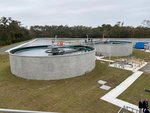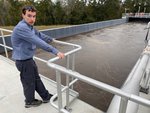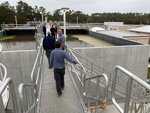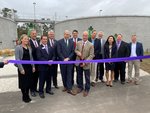




St. Johns County commissioners, utility department employees and other government and business dignitaries celebrated the completion of the Players Club Water Reclamation Facility with a ribbon cutting ceremony Thursday, Dec. 12.
The $32 million project, finished five months ahead of schedule, consolidates wastewater flows from the Players Club, Innlet Beach and Sawgrass wastewater treatment plants in Ponte Vedra Beach into one advanced wastewater treatment facility. It will improve the effluent quality of treated wastewater and is the largest capital project ever undertaken by the Utilities Department.
The celebration ceremony began with a round of speeches, followed by the ribbon cutting, then lunch and tours of the facility off Dyes Valley Road.
“This represents our ongoing commitment to Ponte Vedra and the environment,” St. Johns County Utilities Director Bill Young said in his opening remarks. “We know what we are doing, and we do things right.”
The new facility will allow for a 60% reduction in nutrients, “that’s a hug reduction,” General Doug Burnett, St. Johns River Water Management District chairman said, praising everyone involved for finishing months ahead of schedule. “This is how we’ve got to do business if we want to be successful in the future. I know golfers,” he added, “have got to love this. Golf courses use five percent of ground water in our state.”
Wastewater is water that is flushed down toilets and water that runs down the drain from sinks and showers. In Ponte Vedra Beach, it is residential and commercial because there is no industrial waste in the area, Chief Engineer Scott Trigg said. The wastewater comes out as reclaimed water that is used for golf courses and irrigation. It does not involve drinking water, which is treated separately in different plants.
In his closing-remarks speech, St. Johns County Commissioner Jeb Smith said the vision for the new water reclamation facility began many years ago. “We are setting the pace in new innovation, we are minimizing impacts on the environment, which is absolutely crucial,” he said. “This will provide sustainable services for many generations to come.”
Attendees who chose to take a tour were able to see firsthand how the system works. The facility consists of huge tanks, through which the wastewater flows, going from dirty to clean and clear. Operator Matt Schloss pointed out that from the first tank, where the water is brown, it flows into the next tank, filled with bubbling sludge that is actually millions of organisms—microbes—that feed on the biosolids, removing all contaminants. The final tank contains clear water, which passes through ultraviolet lights, which completely sterilize any remaining organisms that could have gotten through.
The facility is currently processing up to a million gallons a day, Schloss said.
It has the potential, at peak capacity, to process 6.5 million gallons a day.